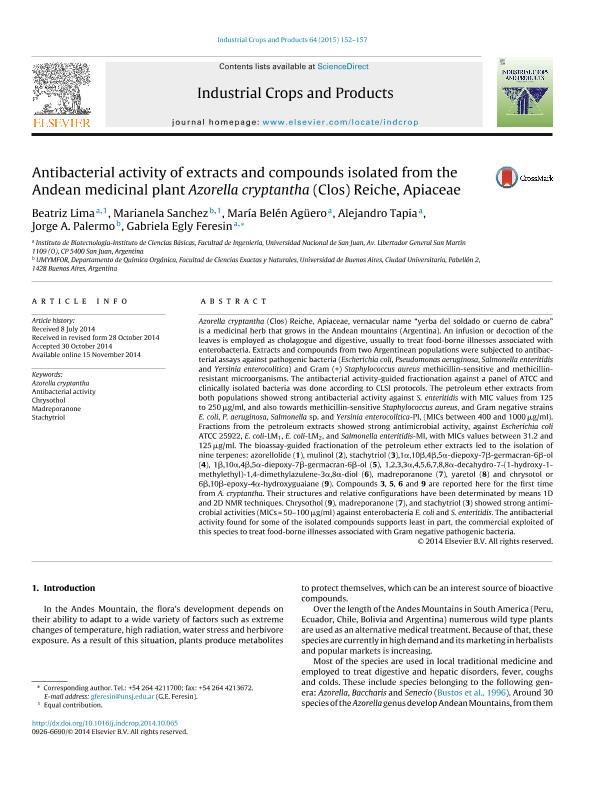Artículo
Antibacterial activity of extracts and compounds isolated from the Andean medicinal plant Azorella cryptantha (Clos) Reiche, Apiaceae
Lima, Beatriz Viviana ; Sánchez, Marianela
; Sánchez, Marianela ; Agüero, María Belén
; Agüero, María Belén ; Tapia, Alejandro; Palermo, Jorge Alejandro
; Tapia, Alejandro; Palermo, Jorge Alejandro ; Feresin, Gabriela Egly
; Feresin, Gabriela Egly
 ; Sánchez, Marianela
; Sánchez, Marianela ; Agüero, María Belén
; Agüero, María Belén ; Tapia, Alejandro; Palermo, Jorge Alejandro
; Tapia, Alejandro; Palermo, Jorge Alejandro ; Feresin, Gabriela Egly
; Feresin, Gabriela Egly
Fecha de publicación:
01/2015
Editorial:
Elsevier
Revista:
Industrial Crops And Products
ISSN:
0926-6690
Idioma:
Inglés
Tipo de recurso:
Artículo publicado
Clasificación temática:
Resumen
Azorella cryptantha (Clos) Reiche, Apiaceae, vernacular name “yerba del soldado or cuerno de cabra” is a medicinal herb that grows in the Andean mountains (Argentina). An infusion or decoction of the leaves is employed as cholagogue and digestive, usually to treat food-borne illnesses associated with enterobacteria. Extracts and compounds from two Argentinean populations were subjected to antibacterial assays against pathogenic bacteria (Escherichia coli, Pseudomonas aeruginosa, Salmonella enteritidis and Yersinia enterocolitica) and Gram (+) Staphylococcus aureus methicillin-sensitive and methicillin-resistant microorganisms. The antibacterial activity-guided fractionation against a panel of ATCC and clinically isolated bacteria was done according to CLSI protocols. The petroleum ether extracts from both populations showed strong antibacterial activity against S. enteritidis with MIC values from 125 to 250 μg/ml, and also towards methicillin-sensitive Staphylococcus aureus, and Gram negative strains E. coli, P. aeruginosa, Salmonella sp. and Yersinia enterocolítica-PI, (MICs between 400 and 1000 μg/ml). Fractions from the petroleum extracts showed strong antimicrobial activity, against Escherichia coli ATCC 25922, E. coli-LM1, E. coli-LM2, and Salmonella enteritidis-MI, with MICs values between 31.2 and 125 μg/ml. The bioassay-guided fractionation of the petroleum ether extracts led to the isolation of nine terpenes: azorellolide (1), mulinol (2), stachytriol (3),1α,10β,4β,5α-diepoxy-7β-germacran-6β-ol (4), 1β,10α,4β,5α-diepoxy-7β-germacran-6β-ol (5), 1,2,3,3α,4,5,6,7,8,8α-decahydro-7-(1-hydroxy-1-methylethyl)-1,4-dimethylazulene-3α,8α-diol (6), madreporanone (7), yaretol (8) and chrysotol or 6β,10β-epoxy-4α-hydroxyguaiane (9). Compounds 3, 5, 6 and 9 are reported here for the first time from A. cryptantha. Their structures and relative configurations have been determinated by means 1D and 2D NMR techniques. Chrysothol (9), madreporanone (7), and stachytriol (3) showed strong antimicrobial activities (MICs = 50–100 μg/ml) against enterobacteria E. coli and S. enteritidis. The antibacterial activity found for some of the isolated compounds supports least in part, the commercial exploited of this species to treat food-borne illnesses associated with Gram negative pathogenic bacteria.
Archivos asociados
Licencia
Identificadores
Colecciones
Articulos(IMIBIO-SL)
Articulos de INST. MULTIDICIPLINARIO DE INV. BIO. DE SAN LUIS
Articulos de INST. MULTIDICIPLINARIO DE INV. BIO. DE SAN LUIS
Articulos(SEDE CENTRAL)
Articulos de SEDE CENTRAL
Articulos de SEDE CENTRAL
Articulos(UMYMFOR)
Articulos de UNID.MICROANAL.Y MET.FISICOS EN QUIM.ORG.(I)
Articulos de UNID.MICROANAL.Y MET.FISICOS EN QUIM.ORG.(I)
Citación
Lima, Beatriz Viviana; Sánchez, Marianela; Agüero, María Belén; Tapia, Alejandro; Palermo, Jorge Alejandro; et al.; Antibacterial activity of extracts and compounds isolated from the Andean medicinal plant Azorella cryptantha (Clos) Reiche, Apiaceae; Elsevier; Industrial Crops And Products; 64; 1-2015; 152-157
Compartir
Altmétricas



